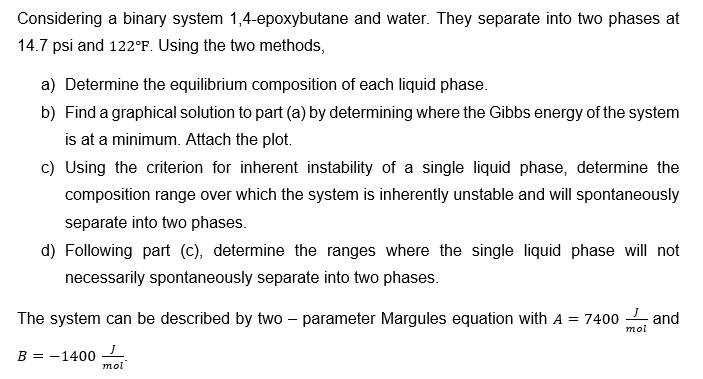Considering a binary system 1,4-epoxybutane and water. They separate into two phases at 14.7 psi and 122°F. Using the two methods, a) Determine the equilibrium composition of each liquid phase. b) Find a graphical solution to part (a) by determining where the Gibbs energy of the system is at a minimum. Attach the plot. c) Using the criterion for inherent instability of a single liquid phase, determine the composition range over which the system is inherently unstable and will spontaneously separate into two phases. d) Following part (c), determine the ranges where the single liquid phase will not necessarily spontaneously separate into two phases. mol The system can be described by two - parameter Margules equation with A = 7400 and B = -1400 mol
Considering a binary system 1,4-epoxybutane and water. They separate into two phases at 14.7 psi and 122°F. Using the two methods, a) Determine the equilibrium composition of each liquid phase. b) Find a graphical solution to part (a) by determining where the Gibbs energy of the system is at a minimum. Attach the plot. c) Using the criterion for inherent instability of a single liquid phase, determine the composition range over which the system is inherently unstable and will spontaneously separate into two phases. d) Following part (c), determine the ranges where the single liquid phase will not necessarily spontaneously separate into two phases. mol The system can be described by two - parameter Margules equation with A = 7400 and B = -1400 mol
Introduction to Chemical Engineering Thermodynamics
8th Edition
ISBN:9781259696527
Author:J.M. Smith Termodinamica en ingenieria quimica, Hendrick C Van Ness, Michael Abbott, Mark Swihart
Publisher:J.M. Smith Termodinamica en ingenieria quimica, Hendrick C Van Ness, Michael Abbott, Mark Swihart
Chapter1: Introduction
Section: Chapter Questions
Problem 1.1P
Related questions
Question
note: please show all the necessary steps/solutions. please answer all. type the asnwers.. thank you...

Transcribed Image Text:Considering a binary system 1,4-epoxybutane and water. They separate into two phases at
14.7 psi and 122°F. Using the two methods,
a) Determine the equilibrium composition of each liquid phase.
b) Find a graphical solution to part (a) by determining where the Gibbs energy of the system
is at a minimum. Attach the plot.
c) Using the criterion for inherent instability of a single liquid phase, determine the
composition range over which the system is inherently unstable and will spontaneously
separate into two phases.
d) Following part (c), determine the ranges where the single liquid phase will not
necessarily spontaneously separate into two phases.
The system can be described by two - parameter Margules equation with A = 7400 and
B = -1400
mol
mol
Expert Solution
This question has been solved!
Explore an expertly crafted, step-by-step solution for a thorough understanding of key concepts.
Step by step
Solved in 4 steps with 35 images

Recommended textbooks for you

Introduction to Chemical Engineering Thermodynami…
Chemical Engineering
ISBN:
9781259696527
Author:
J.M. Smith Termodinamica en ingenieria quimica, Hendrick C Van Ness, Michael Abbott, Mark Swihart
Publisher:
McGraw-Hill Education

Elementary Principles of Chemical Processes, Bind…
Chemical Engineering
ISBN:
9781118431221
Author:
Richard M. Felder, Ronald W. Rousseau, Lisa G. Bullard
Publisher:
WILEY

Elements of Chemical Reaction Engineering (5th Ed…
Chemical Engineering
ISBN:
9780133887518
Author:
H. Scott Fogler
Publisher:
Prentice Hall

Introduction to Chemical Engineering Thermodynami…
Chemical Engineering
ISBN:
9781259696527
Author:
J.M. Smith Termodinamica en ingenieria quimica, Hendrick C Van Ness, Michael Abbott, Mark Swihart
Publisher:
McGraw-Hill Education

Elementary Principles of Chemical Processes, Bind…
Chemical Engineering
ISBN:
9781118431221
Author:
Richard M. Felder, Ronald W. Rousseau, Lisa G. Bullard
Publisher:
WILEY

Elements of Chemical Reaction Engineering (5th Ed…
Chemical Engineering
ISBN:
9780133887518
Author:
H. Scott Fogler
Publisher:
Prentice Hall


Industrial Plastics: Theory and Applications
Chemical Engineering
ISBN:
9781285061238
Author:
Lokensgard, Erik
Publisher:
Delmar Cengage Learning

Unit Operations of Chemical Engineering
Chemical Engineering
ISBN:
9780072848236
Author:
Warren McCabe, Julian C. Smith, Peter Harriott
Publisher:
McGraw-Hill Companies, The